
Willows, also called sallows and osiers, of the genus Salix, comprise around 350 species of typically deciduous trees and shrubs, found primarily on moist soils in cold and temperate regions.

Populus is a genus of 25–30 species of deciduous flowering plants in the family Salicaceae, native to most of the Northern Hemisphere. English names variously applied to different species include poplar, aspen, and cottonwood.
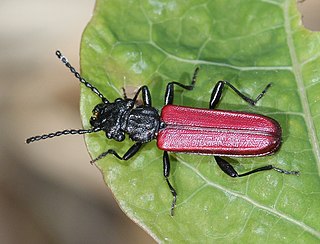
The Cucujidae, or flat bark beetles, are a family of distinctively flat beetles found worldwide under the bark of dead trees. The family has received considerable taxonomic attention in recent years and now consists of 70 species distributed in five genera. It was indicated Cucujus species are scavengers, only feeding on pupae and larvae of other insects and on other subcortical beetles such as their own. Since the Cucujidae prey on larvae of potentially tree damaging beetles that spread fungal diseases, they are considered to be beneficial to the health of living trees.

A bark beetle is the common name for the subfamily of beetles Scolytinae. Previously, this was considered a distinct family (Scolytidae), but is now understood to be a specialized clade of the "true weevil" family (Curculionidae). Although the term "bark beetle" refers to the fact that many species feed in the inner bark (phloem) layer of trees, the subfamily also has many species with other lifestyles, including some that bore into wood, feed in fruit and seeds, or tunnel into herbaceous plants. Well-known species are members of the type genus Scolytus, namely the European elm bark beetle S. multistriatus and the large elm bark beetle S. scolytus, which like the American elm bark beetle Hylurgopinus rufipes, transmit Dutch elm disease fungi (Ophiostoma). The mountain pine beetle Dendroctonus ponderosae, southern pine beetle Dendroctonus frontalis, and their near relatives are major pests of conifer forests in North America. A similarly aggressive species in Europe is the spruce ips Ips typographus. A tiny bark beetle, the coffee berry borer, Hypothenemus hampei is a major pest on coffee plantations around the world.

A plant canker is a small area of dead tissue, which grows slowly, often over years. Some cankers are of only minor consequence, but others are ultimately lethal and therefore can have major economic implications for agriculture and horticulture. Their causes include a wide range of organisms as fungi, bacteria, mycoplasmas and viruses. The majority of canker-causing organisms are bound to a unique host species or genus, but a few will attack other plants. Weather and animal damage can also cause stress to the plant resulting in cankers. Other causes of cankers is pruning when the bark is wet or using un-sterilized tools.

Laothoe populi, the poplar hawk-moth, is a moth of the family Sphingidae. The species was first described by Carl Linnaeus in his 1758 10th edition of Systema Naturae. It is found throughout the Palearctic region and the Near East and is one of the most common members of the family in the region. It is distinctive due to its habit of resting with its hindwings held further forward than the forewings.

The poplar admiral is a butterfly in the Limenitidine clade of the family Nymphalidae.
Brenneria is a genus of Pectobacteriaceae, containing mostly pathogens of woody plants. This genus is named after the microbiologist Don J. Brenner.
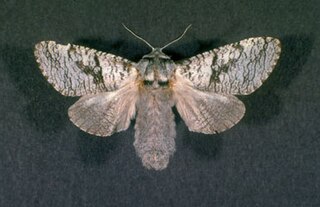
Acossus populi, the aspen carpenterworm, is a moth of the family Cossidae. It is found in the United States in Nevada, Colorado, California and in the northern Rocky Mountains. In Canada it is found in Ontario and British Columbia.
Brachylomia populi is a moth of the family Noctuidae first described by Ferdinand Heinrich Hermann Strecker in 1898. It is found in the inland mountains of western North America, from British Columbia and Alberta and to the south through Colorado and Utah into Arizona.

Tyrpophloeus populi is a species of bark beetle that have been suggested as the cause of sudden aspen decline. It was first described by the American entomologist Andrew Delmar Hopkins.
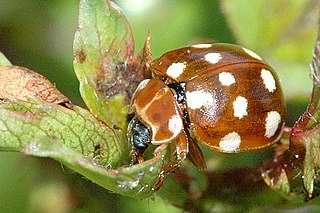
Calvia quatuordecimguttata, the cream-spot ladybird, is a species of ladybird in the family Coccinellidae. Its distribution is holarctic, it being found in Europe and through the East Palearctic to Japan. It is introduced to North America. This ladybird is generally 4 to 5 millimetres in length and varies in appearance depending on the geographical location. It usually lives in hedgerows and deciduous trees.

Chrysomela populi is a species of broad-shouldered leaf beetle belonging to the family Chrysomelidae, subfamily Chrysomelinae.

Chrysomela is a genus of leaf beetles found almost throughout the world, but not in Australia. It contains around 40 species, including 7 in eastern and northern Europe. It also includes at least 17 species in North America, including the cottonwood leaf beetle Chrysomela scripta.

Aspen is a common name for certain tree species; some, but not all, are classified by botanists in the section Populus, of the Populus genus.
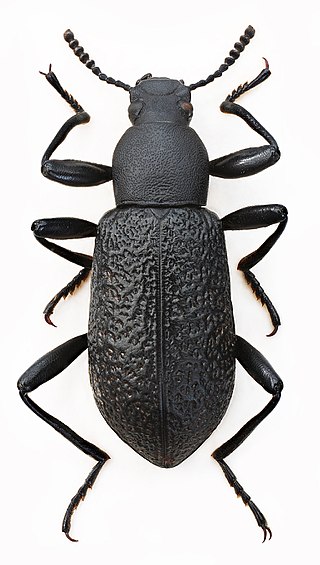
Upis ceramboides is a species of beetle, one of many wood-living insects that benefit from forest fires. It often occurs in quantities below the bark on the fire-damaged birches, but can sometimes be seen on other deciduous trees such as willow and aspen. The larvae thrive in the inner bark which is rich in mycelia, and in the sapwood. They develop into pupae during the summer months under the bark, and they develop over two or three years. The following spring they reproduce themselves.
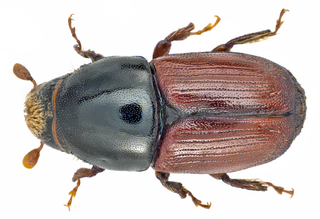
Scolytus scolytus, the larger European elm bark beetle or large elm bark beetle, is a 3.5–6 mm long bark beetle species. It is of significant importance in Eurasia as a vector of Dutch elm disease.
Procryphalus is a genus of typical bark beetles in the family Curculionidae. There are about seven described species in Procryphalus.
Trypophloeus striatulus, the willow bark beetle, is a species of typical bark beetle in the family Curculionidae.
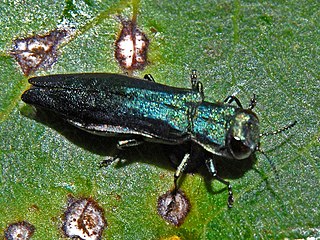
Agrilus suvorovi is a species of beetle in the family Buprestidae, the jewel beetles.
















